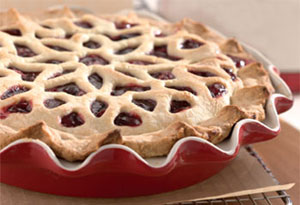Secrets for Making the Perfect Pie Crust
Ah, the perfect pie crust: golden brown top and bottom; flaky, tender, and flavorful. Struggling to make the perfect pie crust? Is your crust tough, stiff, burned, or soft on the bottom?

- For a tender crust, use all-purpose or pastry flour. Higher-protein flour (e.g., bread flour) will yield a tough crust.
- For flakiest texture, use ice-cold fat. Work it into the dry ingredients with a pastry blender, fork, or your fingers.
- Don’t blend fat into flour thoroughly; leave some of it in larger, pea- or marble-size pieces. Chunks of fat will help create space between the layers of pastry; these layers translate to flakiness in the baked crust.
- Sprinkle 1 teaspoon cider or white vinegar over the flour mixture; this will help relax the gluten, and promote a tender crust. Add ice water, sprinkling it in a tablespoon at a time as you gently stir.
- When the dough starts to come together, transfer it to a piece of parchment. Squeeze it into a ball. If it holds together nicely, it’s ready. If it seems dry and chunks break off, spritz with additional ice water.
- Use the parchment to press the dough together until it’s cohesive. Fold the dough over on itself three or four times to bring it together. This folding process helps create layers, which translate into flakiness.
- If you’re making a double-crust recipe, divide dough in half. To avoid ragged edges as you roll, flatten each piece into a rough disk, then roll like a wheel across a floured work surface, to smooth the edges.
- What’s the easiest way to transfer rolled crust to a pie plate? Pick it up with a giant spatula, and gently settle it into the plate. Never stretch the crust; doing so will cause it to shrink as the pie bakes.
- Here’s a simple way to make a fancy edge on your perfect pie. Using the index finger of one hand, and the thumb and index of the other, crimp the crust between your fingers, moving around the perimeter of the pie.
Pie Crust Tips
- Cold ingredients produce the flakiest crust. Be sure to use very cold fat. In warm weather, it helps to chill the flour ahead.
- Cut the fat in until your mixture resembles small peas or gravel. The more you incorporate the fat past that point, the less flaky your crust will be.
- If you are making a double crust pie, it helps to have a little extra dough for the bottom crust. Divide the dough in two, making one part slightly larger than the other.
- Pastry handles better when chilled than at room temperature - 30 to 40 minutes in the refrigerator before rolling is usually sufficient.
- You can chill pastry in the refrigerator for longer than 40 minutes - up to 2 or 3 days if it is wrapped well. If you do store it this long, let it sit at room temperature for 5 or 10 minutes before rolling to allow the dough to become more pliable.
- Roll your pastry on a sheet of lightly floured wax paper. Invert the pastry right over the pan, or filling, and peel the paper off.
- You can patch tears in pastry by pinching or pressing it back together. Large gaps can be patched with trimmings cut from the overhanging dough.
- Don't stretch the pastry when you are lining a pie pan with the bottom crust. Rather, ease the pastry into the pan, gently tucking it into the bottom crease.
- For added luster, sparingly brush your top crust with cream just before baking. In addition, you may sprinkle a large pinch or two of sugar over the top for an extra bit of sweetness.
Attribution
Recipe and photo used with permission from: King Arthur Flour
Air Fryer ~ American Regional ~ Appetizers ~ Baby Food ~ Back of the Box ~ Beans ~ Beverages ~ Bowls/Buddha Bowls ~ Bread ~ Breakfast/Brunch ~ Camping/Hiking ~ Candy ~ Canning ~ Casseroles ~ Celebrity ~ Condiments ~ Cookies ~ Cooking for a Crowd ~ Cooking for Two ~ Cowboy/Ranch ~ Crock Pot ~ Dessert ~ Diet ~ Energy Bars ~ Family Favorites ~ Fish/Seafood ~ Gifts in a Jar ~ Grill ~ Holidays ~ Home Remedies ~ Instant Pot ~ International ~ Jiffy Mixes ~ LuAnn's Family Favorites ~ Meat ~ Meatless ~ Mixes ~ Name Brand ~ Nutella ~ Packet Cooking ~ Pampered Chef ~ Pasta/Rice/Beans ~ Pet Food ~ Picnic ~ Pizza ~ Potluck ~ Pressure Cooker ~ Restaurant ~ Salads/Salad Dressings ~ Sandwiches ~ Sauces ~ School Cafeteria ~ Seasoning/Flavored Oil/Vinegar ~ Sheet Pan ~ Side Dishes/Veggies ~ Snacks ~ Soup/Stew/Chili ~ Spreads ~ State Fair ~ Syrup ~ Tofu ~ TVP ~ Two-Ingredients ~ Vegetarian ~ Wild Game
Articles ~ Cooks Corner ~ Glossary (Dictionary) ~ Household Hints ~ Kitchen Hints

